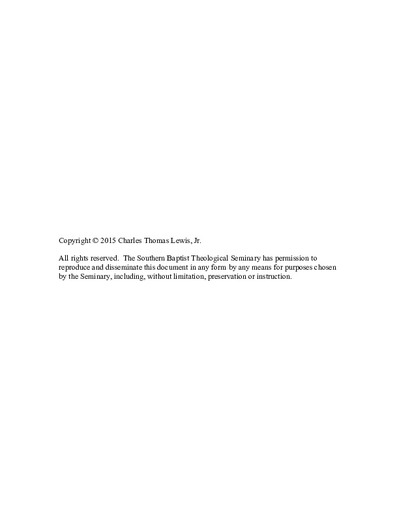Far and Near: Christian Worship of the Transcendent and Immanent God of Wonders
Subject
Transcendence of God.Immanence of God.
Public worship in the Bible.
Bible--Prayers.
Public worship--Baptists.
Abstract
ABSTRACT
FAR AND NEAR:
CHRISTIAN WORSHIP OF THE TRANSCENDENT AND IMMANENT GOD OF WONDERS
Charles Thomas Lewis, Jr., Ph.D.
The Southern Baptist Theological Seminary, 2015
Chair: Dr. Bruce A. Ware
"Far and Near: Christian Worship of the Transcendent and Immanent God of Wonders" examines the rhythm of transcendence then immanence represented in divine worship encounters and significant prayers recorded in Scripture. With the objective of determining how transcendence and immanence shapes modern worship services in Southern Baptist churches, this dissertation also documents the goals, values, and objectives that may influence how worship pastors in Southern Baptist churches select and sequence elements to be included in their corporate worship services.
Chapter 1 establishes the propensity of the modern church to bypass the transcendence of God while rushing to embrace God's immanence. Chapter 2 discusses the age of immanence and individualism--two modern mindsets permeating religious thinking and corporate worship of many Christians in modern times. This chapter also discusses the residual effects of the loss of focus on God's transcendence--the centralization of man coupled with the displacement of God from his rightful place of centrality in worship.
Using the findings of the Worship Design Project 2014, chapter 3 is an empirical documentation of worship praxis and design by worship pastors in the most attended Southern Baptist churches in the United States. Chapter 4 discusses the biblical historical grounding of transcendence including God's transcendent holiness, aseity, sovereignty, constancy, omnipotence, omniscience, omnipresence, and timeless eternality. Chapter 5 considers how God's immanent attributes are rooted in and flow from his transcendent characteristics.
Chapter 6 is a Christological reflection on how Jesus Christ--God immanently with us--remains transcendent in relationship to his creation and his church. Chapter 7, the central focus of this dissertation, uses biblical data to demonstrate the rhythm of transcendence then immanence represented in divine worship encounters and prayer. Chapter 8 addresses the implications of properly balanced and ordered transcendence and immanence for modern worship service planning and design in the free church tradition.
The thesis advanced in this dissertation is that, in divine-human encounters, the Bible demonstrates a repeated pattern of conceptualizing and understanding God in his transcendent otherness both prior to his immanence and as the framework within which his immanence can only be rightly understood and experienced.

